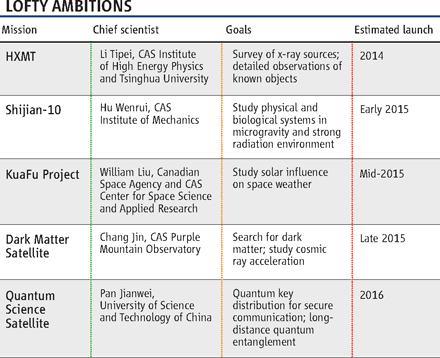By Hao Xin on Science 20 May 2011: 904. Full Text (PDF)
BEIJING—In 1993, Li Tipei envisioned a novel space telescope that would use a simple design but sophisticated math to reconstruct images of far-flung objects from the hard x-rays and gamma rays they emit. After years of delays, Li's dream is about to come true. On 3 May, Wu Ji, director of the Center for Space Science and Applied Research of the Chinese Academy of Sciences here, told Chinese media that the Hard X-ray Modulation Telescope (HXMT) is the first of five space science missions slated for launch in CAS's decadal plan, which began this year.

CREDIT: COURTESY WU JI
The bevy of missions marks a turning point for Chinese space science. China has sent more than 100 satellites into space, but only one, Wu told Science, had a dedicated science mission: Double Star, a project with Europe in which two satellites carried out research on magnetic storms from 2004 to 2007. All other satellites have served purposes such as telecommunications, surveillance, remote sensing, and weather forecasting. Even China's two lunar missions—Chang'e-1 and -2—were driven primarily by engineering goals and science came second, Wu says.
Now space science, a poor stepchild under the China National Space Administration (CNSA), has found in CAS a new parent keen to boost its development. Under CAS's new Innovation 2020 program, space science is slated to receive 3.6 billion RMB ($554 million) over the next 5 years. During this period, the academy plans to establish a National Space Science Center with a stable budget to oversee space research projects.
For years, China's space science enterprise has been held back because its erstwhile overseer, CNSA, is a space agency in name only: It has no budget, no personnel, and no mandate other than to represent China in the international space arena. The real power resides with the State Administration for Science, Technology and Industry for National Defense (SASTIND), whose director doubles as CNSA head. But SASTIND is a weakened descendant of an agency that spun off a military department in the late 1990s that now controls rocket launches and the manned space program. That left SASTIND, nominally a civilian agency, to run a utilitarian unmanned program. SASTIND's culture of secrecy runs counter to the openness required for science, say Chinese researchers, who welcome CAS's taking the lead.
HXMT is not the only mission being thrown a lifeline. Another is KuaFu, a Sino-Canadian mission to study the sun's influence on space weather (Science, 4 August 2006, p. 607). China will contribute $154 million to the project and plans to send a satellite in early 2015 to a patch of space where the solar wind and Earth's magnetosphere are roughly equal in force, creating a kind of eddy where the craft will hover and train its gaze on the sun. Canada would put two complementary satellites into polar Earth orbit in 2016 or 2017.

X-ray vision.
China plans to launch HXMT, its first space telescope, in 2014, Wu Ji says.
CREDIT: COURTSEY OF IHEP, CAS (INSET)
CAS will also fund research and design work on two new missions that are aiming for launch in the second half of the decade. One satellite would be on the lookout for gamma rays produced when dark matter particles annihilate each other. The craft would also tune in to a high-energy electron spectrum that may shed light on the mysterious propagation and acceleration of cosmic rays.
A second satellite in development intends to make a quantum leap in space science. One goal is to implement high-speed quantum key distribution between the satellite and Earth stations as a test bed for secure intercontinental quantum communication, says the mission's chief scientist, physicist Pan Jianwei of the University of Science and Technology of China in Hefei. A second aim is to install a source on the satellite that would generate photon pairs whose quantum states are highly correlated. Such entangled photon pairs can be used to investigate long-distance distribution of entanglement, experiment with quantum teleportation—instantly transporting quantum information to another location—and test principles of quantum mechanics.
To realize these aspirations, CAS is counting on HXMT—China's first space telescope—to pave the way. From its low Earth orbit, HXMT would operate in a wide-field mode, cataloging objects such as x-ray binary systems and supermassive black holes, or in a pointing mode to zero in on known sources. The finance ministry has allocated $123 million toward the satellite's construction. CAS and SASTIND will split the $30.6 million cost of building the telescope.
HXMT and other science missions will not be entirely independent of the military, which builds China's rockets and puts them in orbit. For SASTIND missions, the army customarily waives the $15.3 million launch fee, sources say. Whether CAS can persuade the military to foot the bill for launching other satellites on its roster of upcoming missions may be a critical test of its ability to get the country's space science truly off the ground.


